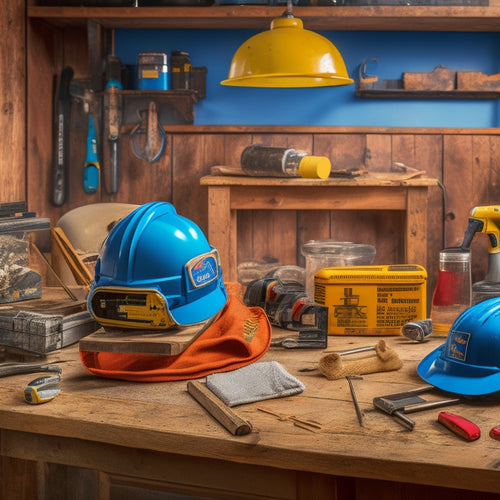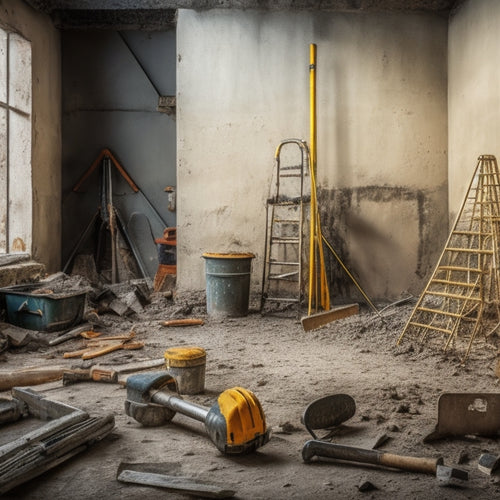
3 Must-Have Epoxy Tools for Home Renovation Success
Share
When it comes to home renovation, having the right epoxy tools is vital for bonding success. You'll need a good scraper or sandpaper for surface preparation, a degreaser and lint-free cloth for cleaning, and a mixing stick or paddle with a clean, dry container for epoxy mixing. These three must-haves will guarantee a strong bond and prevent common mistakes. With these essentials in your toolkit, you'll be well on your way to a successful renovation - and with a few more tips and tricks up your sleeve, you'll be unstoppable.
Key Takeaways
• Invest in a good quality scraper or sandpaper for surface preparation to remove dirt and old adhesives.
• Utilize a degreaser and lint-free cloth to ensure a clean surface, free from impurities and oils.
• Use a mixing stick or paddle along with a clean, dry container for epoxy mixing to avoid air pockets and contamination.
• Employ a scale or measuring cups for accurate resin to hardener ratios to achieve a strong and durable bond.
• Implement scraping techniques and use bubble-releasing tools or heat guns to eliminate trapped air and achieve a smooth finish.
Essential Tools for Bonding Success
To guarantee a strong and durable bond, you'll need a set of essential tools that will help you prepare, mix, and apply epoxy resin with precision and control.
Surface preparation is critical, so invest in a good quality scraper or sandpaper to remove dirt, oil, and old adhesives. A degreaser and a lint-free cloth will also come in handy to guarantee a clean surface.
For epoxy mixing, you'll need a mixing stick or paddle, as well as a clean, dry mixing container. A scale or measuring cups will help you achieve the perfect ratio of resin to hardener. To avoid air bubbles, use a mixing technique that involves scraping the sides and bottom of the container. A bubble-releasing tool or a heat gun can also be useful in removing trapped air.
Other essential tools include clamps or weights to hold the pieces together, a timer to guarantee the correct curing time, and a well-ventilated workspace.
With these tools, you'll be well on your way to achieving a strong and durable bond that will last for years to come. By mastering epoxy mixing and surface preparation, you'll be able to tackle even the most complex home renovation projects with confidence.
Mastering Epoxy Application Techniques
How do you guarantee a smooth, even epoxy application that meets your project's specific requirements? It all comes down to mastering the techniques that assure a successful outcome. Here are some essential tips to get you started:
-
Epoxy Mixing Mastery: Make sure you mix your epoxy correctly, following the manufacturer's instructions to the letter. This includes mixing the right ratio of resin to hardener, mixing thoroughly, and avoiding air pockets.
-
Surface Preparation: Prepare your surface by cleaning it thoroughly, removing any grease or oil, and sanding it to create a rough texture for the epoxy to bond to.
-
Temperature Control: Confirm your workspace is at the recommended temperature for epoxy application, usually between 70°F to 80°F (21°C to 27°C).
- Application Technique: Use the right tools, such as a notched trowel or a spreader, to apply the epoxy evenly and smoothly. Work in small sections, and use a level to confirm the application is straight and even.
Achieving a Strong Concrete Bond
You've mastered the epoxy application techniques, now it's time to focus on the foundation of your project - a strong concrete bond. This vital step guarantees your epoxy coating adheres properly, resulting in a durable and long-lasting finish.
To achieve this, surface preparation is key. Make certain the concrete surface is clean, dry, and free of any oil or grease. Use a degreaser and a wire brush to remove any impurities, and then etch the surface with a concrete etcher to create a rough texture for the epoxy to bond to.
Next, apply a bonding agent to the prepared surface, following the manufacturer's instructions. This will help create a strong bond between the concrete and epoxy. Once you've applied the epoxy, confirm it's allowed to cure for the recommended amount of time.
Curing times vary depending on the specific epoxy product, so be sure to follow the instructions carefully. By focusing on surface preparation and allowing for proper curing times, you'll be able to achieve a strong concrete bond that will withstand the test of time.
With a solid foundation in place, you can move forward with confidence, knowing your epoxy coating will last for years to come.
Frequently Asked Questions
How Do I Remove Epoxy From My Skin and Surfaces?
When epoxy gets stuck on your skin or surfaces, don't panic!
For epoxy skin removal, use acetone or mineral spirits to gently scrub the area. Wash with soap and water, then moisturize.
For epoxy surface cleaning, mix baking soda and water to create a paste. Apply it to the affected area, let it sit, and then scrape it off with a credit card or similar tool.
What Safety Precautions Should I Take When Working With Epoxy?
You're about to plunge into epoxy work, and wisely, you're thinking about safety first!
Did you know that epoxy-related accidents send over 10,000 people to the ER annually? To avoid becoming a statistic, you'll need to gear up with epoxy safety gear, including gloves, goggles, and a mask.
Don't forget to guarantee proper ventilation requirements, like working in a well-ventilated area or using a respirator.
Can I Use Epoxy on Wet or Damp Surfaces?
When working with epoxy, you'll face epoxy adhesion challenges if you apply it to wet or damp surfaces.
Moisture affects the bonding process, causing the epoxy to lift or peel off over time.
To guarantee a strong bond, make sure the surface is dry and free of moisture.
If you're dealing with a damp area, take the time to dry it out before applying epoxy.
It's worth the extra effort to get it right, as a strong bond is essential for a successful renovation.
How Long Does Epoxy Take to Fully Cure and Harden?
You've probably wondered if epoxy is like concrete, taking ages to fully harden. But the truth is, epoxy's curing time is quite impressive!
On average, epoxy takes around 24 hours to fully cure and harden at room temperature. However, the epoxy hardening process can be influenced by factors like temperature, humidity, and thickness of application.
You'll notice it starts to harden within 15-20 minutes, but patience is key to achieving a strong, durable bond.
Is Epoxy Suitable for Outdoor Projects Exposed to Weather?
When working on outdoor projects, you're probably wondering if epoxy is suitable for exposure to the elements.
The good news is that epoxy durability and weather resistance make it an excellent choice. Most epoxies are formulated to withstand UV rays, rain, and extreme temperatures.
However, you'll still need to choose an epoxy specifically designed for outdoor use and follow the manufacturer's instructions for application and curing.
Conclusion
You've got the right stuff to tackle that home renovation project, and with these three must-have epoxy tools, you're on a roll!
Don't let your project go off the rails - having the right tools is half the battle.
Now that you've got the essentials, it's time to hammer out the details and get bonding!
Remember, when it comes to epoxy, practice makes perfect, so don't be afraid to get your hands dirty and experiment until you nail it.
Related Posts
-

7 Best Home Renovation Project Checklists With Timelines
You're about to initiate a home renovation project, and establishing a clear plan with timelines is vital to staying ...
-

Top 3 Safety Essentials for DIY Renovations
When tackling a DIY renovation, you'll want to prioritize three essential safety items to protect yourself from poten...
-

What Tools to Rent for Block Wall Renovation
When renovating a block wall, it's vital to have the right tools for the job. You'll need demolition tools like pry b...


